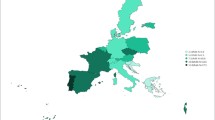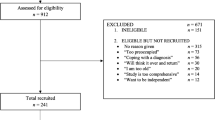Abstract
Objectives
In-hospital falls in older patients are frequent, but the identification of patients at risk of falling is challenging. Aim of this study was to improve the identification of high-risk patients. Therefore, a simplified screening-tool was developed, validated, and compared to the STRATIFY predictive accuracy.
Design
Retrospective analysis of 4,735 patients; evaluation of predictive accuracy of STRATIFY and its single risk factors, as well as age, gender and psychotropic medication; splitting the dataset into a learning and a validation sample for modelling fall-risk screening and independent, temporal validation.
Setting
Geriatric clinic at an academic teaching hospital in Hamburg, Germany.
Participants
4,735 hospitalised patients ≥65 years.
Measurements
Sensitivity, specificity, positive and negative predictive value, Odds Ratios, Youden-Index and the rates of falls and fallers were calculated.
Results
There were 10.7% fallers, and the fall rate was 7.9/1,000 hospital days. In the learning sample, mental alteration (OR 2.9), fall history (OR 2.1), and insecure mobility (Barthel-Index items ‘transfer’ + ‘walking’ score = 5, 10 or 15) (OR 2.3) had the most strongest association to falls. The LUCAS Fall-Risk Screening uses these risk factors, and patients with ≥2 risk factors contributed to the high-risk group (30.9%). In the validation sample, STRATIFY SENS was 56.8, SPEC 59.6, PPV 13.5 and NPV 92.6 vs. LUCAS Fall-Risk Screening was SENS 46.0, SPEC 71.1, PPV 14.9 and NPV 92.3.
Conclusions
Both the STRATIFY and the LUCAS Fall-Risk Screening showed comparable results in defining a high-risk group. Impaired mobility and cognitive status were closely associated to falls. The results do underscore the importance of functional status as essential fall-risk factor in older hospitalised patients.
Similar content being viewed by others
References
Thomas EJ, Brennan TA (2000) Incidence and types of preventable adverse events in elderly patients: population based review of medical records. BMJ 320:741–744.
Healey F, Scobie S, Oliver D et al (2008) Falls in English and Welsh hospitals: A national observational study based on retrospective analysis of 12 months of patient safety incident reports. Qual Saf Health Care 17:424–430.
Brand CA, Sundararajan V (2010) A 10-year cohort study of the burden and risk of in-hospital falls and fractures using routinely collected hospital data. Qual Saf Health Care. doi:10.1136/qshc.2009.038273.
Bates DW, Pruess K, Souney P et al (1995) Serious falls in hospitalized patients: Correlates and resource utilization. Am J Med 99:137–143.
Hill KD, Vu M, Walsh W (2007) Falls in the acute hospital setting -impact on resource utilization. Aust Health Rev 31:471–477.
Rubenstein LZ (2006) Falls in older people: Epidemiology, risk factors and strategies for prevention. Age Ageing 35(Suppl2):ii37–ii41.
Oliver D, Connelly J, Victor C et al (2007) Strategies to prevent falls and fractures in hospitals and care homes and effect of cognitive impairment. Systematic review and meta-analyses. BMJ 334:82–87.
Coussement J, De Paepe L, Schwendimann R et al (2007) Interventions for preventing falls in acute and chronic care settings. J Am Geriatr Soc 56:29–36.
Stern C, Jayasekara R (2009) Interventions to reduce the incidence of falls in older adult patients in acute-care hospitals: a systematic review. Int J Evid Based Healthc 7:243–249.
Oliver D, Healey F, Haines TP (2010) Preventing falls and fall-related injuries in hospitals. Clin Geriatr Med 26:645–692.
Cameron ID, Murray GR, Gillespie LD et al (2010) Interventions for preventing falls in older people in nursing care facilities and hospitals. Cochrane Database Syst Rev 20;1:CD005465.
Oliver D, Daly F, Martin FC et al (2004) Risk factors and risk assessment tools for falls in hospital in patients: a systematic review. Age Ageing 33:122–130.
Morse JM, Black C, Oberle K et al (1989) A prospective study to identify the fallprone patient. Soc Sci Med 28:81–86.
Petitpierre NJ, Trombetti A, Carroll I et al (2010) The FIM® instrument to identify patients at risk of falling in geriatric wards: a 10-year retrospective study. Age Ageing 39:326–331.
Brown CJ, Friedkin RJ, Inouye SK (2004) Prevalence and outcomes of low mobility in hospitalized older patients. J Am Geriatr Soc 52:1263–1270.
Renteln-Kruse von W, Dapp U, Anders J et al (2011) The LUCAS consortium — interdisciplinary research on ageing and health care for older people in an urban community. Z Gerontol Geriat 44:250–255.
Dapp U, Anders JA, von Renteln-Kruse W et al (2011) A randomized trial of effects of a health risk appraisal combined with group sessions or home visits on preventive behaviors in older adults. J Gerontol A Biol Med Sci 66:591–598.
Oliver D, Papaioannou A, Gianggregorio L et al (2008) A systematic review and meta-analysis of studies using the STRATIFY tool for prediction of falls in hospital patients: how well does it work? Age Ageing 37:621–627.
Oliver D, Britton M, Seed P et al (1997) Development and evaluation of evidence based risk assessment tool (STRATIFY) to predict which elderly inpatients will fall: case-control and cohort studies. BMJ 315:1049–1053.
Renteln-Kruse von W, Krause T (2007) Incidence of in-hospital falls in geriatric patients before and after the introduction of an interdisciplinary team-based fallprevention intervention. J Am Geriatr Soc 55:2068–2074.
Steyerberg EW, Harrell Jr FE, Borsboom GJJM (2001) Internal validation of predictive models: efficiency of some procedures for logistic regression analysis. J Clin Epidemiol 54:774–781.
Kellog International Work Group on the Prevention of Falls by the Elderly (1987) The prevention of falls in later life. A report of the Kellogg International Work Group on the prevention of falls by the elderly. Dan Med Bull 34:1–24.
Renteln-Kruse von W, Krause T (2004) Sturzereignisse stationärer geriatrischer Patienten — Ergebnisse einer 3-jährigen prospektiven Erfassung. Z Gerontol Geriat 37:9–14.
Kallin K, Gustafson Y, Sandman P-O et al (2004) Drugs and falls in older people in geriatric care settings. Aging Clin Exp Res 16:270–276.
Lübke N, Meinck M, von Renteln-Kruse W (2004) Der Barthel-Index in der Geriatrie. Eine Kontextanalyse zum Hamburger Einstufungsmanual. Z Gerontol Geriat 37:316–326.
Haines TP, Hill K, Walsh W et al (2007) Design-related bias in hospital fall screening tool predictive accuracy evaluations: systematic review and meta-analysis. J Gerontol A Biol Sci Med Sci 62:664–672.
Webster J, Courtney M, O’Rourke P et al (2008) Should elderly patients be screened for their’ fall risk’? Validity of the STRATIFY falls screening tool and predictors of falls in a large acute hospital. Age Ageing 37:702–706.
Schwendimann R, Bühler H, De Geest S et al (2006) Falls and consequent injuries in hospitalized patients: effects of an interdisciplinary falls prevention program. BMC Health Serv Res 6:69–75.
Chapman J, Bachand D, Hyrkäs K (2011) Testing the sensitivity, specificity and feasibility of four falls risk assessment tools in a clinical setting. J Nurs Manag 19:132–142. DOI 10.1111/j.1365-2834.2010.01218.x.
Barker A, Kamar J, Morton A et al (2009) Bridging the gap between research and practice: review of a targeted hospital inpatient fall prevention programme. Qual Saf Health Care 18:467–472.
Tan KM, Austin B, Shaugnassy M et al (2005) Falls in an acute hospital and their relationship to restraint use. Irish J Med Sci 174:28–31.
Smith J, Forster A, Young J (2006) Use of the ’sTRATIFY’ falls risk assessment in patients recovering from acute stroke. Age Ageing 35:138–143.
Papaioannou A, Parkinson W, Cook R et al (2004) Prediction of falls using a risk assessment tool in the acute care setting. BMC Medicine 2:1–7; http://www.biomedcentral.com/1741-7015/2/1.
Hitcho EB, Krauss MJ, Birge S et al (2004) Characteristics and circumstances of falls in a hospital setting. J Gen Intern Med 19:732–739.
Salameh F, Cassuto N, Oliven A (2008) A simplified fall-risk assessment tool for patients hospitalized in medical wards. Isr Med Ass J 10:125–129.
Renteln-Kruse von W, Krause T, Dieckmann P et al (2006) Geriatric patients’ mobility status as reflected by the relevant items of the Barthel Index and in-hospital falls. J Am Geriatr Soc 54:1012–1013.
Hauer K, Marburger C, Oster P (2002) Motor performance deteriorates with simultaneously performed cognitive tasks in geriatric patients. Arch Phys Med Rehabil 83:217–223.
Hignett S, Sands G, Griffiths P (2011) Exploring the contributory factors for un-witnessed in-patient falls from the National Reporting and Learning System database. Age Ageing 40:135–138.
Hack K, Zhao X (2011) How dangerous is a day in hospital? A model of adverse events and length of stay for medical inpatients. Med Care 49:1068–1075.
Halfon P, Eggli Y, Van Melle G et al (2001) Risk of falls for hospitalized patients: A predictive model based on routinely available data. J Clin Epidemiol 54:1258–1266.
Meyers H, Nikoletti S (2003) Fall risk assessment: a prospective investigation of nurses’ clinical judgement and risk assessment tools in predicting patient falls. Int J Nurs Pract 9:158–165.
Nordin E, Lindelöf N, Rosendal E et al (2008) Prognostic validity of the Timed Up-and-Go test, a modified Get-Up-and-Go test, staff’s global judgement and fall history in evaluating fall risk in residential care facilities. Age Ageing 37:442–448.
Vassallo M, Poynter L, Sharma JC et al (2008) Fall risk-assessment tools compared with clinical judgement: an evaluation in a rehabilitation ward. Age Ageing 37:277–281.
Haines T, Kuys SS, Morrison G et al (2009) Cost-effectiveness analysis of screening for risk of in-hospital falls using physiotherapist clinical judgement. Med Care 47:448–456.
Webster J, Courtney M, Marsh N et al (2010) The STRATIFY tool and clinical judgement were poor predictors of falling in an acute hospital setting. J Clin Epidemiol 63:109–113.
Healey F, Monro A, Cockram A et al (2004) Using targeted risk factor reduction to prevent falls in older in-patients: a randomised controlled trial. Age Ageing 33:390–395.
Milisen K, Coussement J, Flamaing J et al (2012) Fall prediction to nurses’ clinical judgment: differences between medical, surgial, and geriatric wards. J Am Geriatr Soc 60:1115–1121.
Lakhan P, Jones M, Wilson A et al (2011) A prospective cohort study of geriatric syndromes among older medical patients admitted to acute care hospitals. J Am Geriatr Soc 59:2001–2008.
Buchner DM, Larson EB (1987) Falls and fractures in patients with Alzheimer-type dementia. JAMA 257:1492–1495.
Clough-Gorr KM, Erpen T, Gillmann G et al (2008) Preclinical disability as a risk factor for falls in community-dwelling older adults. J Gerontol A Biol Sci Med Sci 63:314–320.
Author information
Authors and Affiliations
Corresponding author
Additional information
Lilli Neumann and Verena Hoffmann contributed equally to this work.
Rights and permissions
About this article
Cite this article
Neumann, L., Hoffmann, V.S., Golgert, S. et al. In-hospital fall-risk screening in 4,735 geriatric patients from the LUCAS project. J Nutr Health Aging 17, 264–269 (2013). https://doi.org/10.1007/s12603-012-0390-8
Published:
Issue Date:
DOI: https://doi.org/10.1007/s12603-012-0390-8




